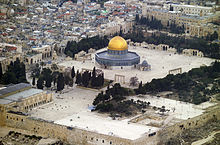

| Part of a series on |
| Muhammad |
|---|
The Israʾ and Miʿraj (Arabic: الإسراء والمعراج, al-’Isrā’ wal-Miʿrāj) are the two parts of a Night Journey that Muslims believe the Islamic prophet Muhammad (AD 570–632) took during a single night around the year AD 621 (1 BH – 0 BH). Within Islam, the majority of Islamic scholars claim that the journey was both a physical and spiritual one.[1][2] Islamic tradition believes a brief mention of the story is found in the 17th surah (chapter) of the Quran, called al-Isra',[3] while details of the story are found in the hadith (the later collections of the reports, teachings, deeds and sayings of Muhammad).
In the Israʾ ("Night Journey"), Muhammad is said to have traveled on the back of Buraq (a winged horse-like bird) to Al-Aqsa (i.e. the Noble Sanctuary), where he led other prophets including Ibrahim (Abraham), Musa (Moses), and Isa (Jesus) in prayer.[4]
Muhammad then ascended into heaven during the Miʿraj (Ascension), where he individually greeted the prophets, and later spoke to God, who agreed to lower the number of required ṣalāt (ritual prayer) from 50 a day to only five. The story of the journey and ascent are marked as one of the most celebrated in the Islamic calendar—27th of the Islamic month of Rajab.[5]
- ^ "The Mi'raaj: physical or spiritual? Fatwa No: 83413". Islamweb.net. 17 October 2001. Retrieved 14 October 2023.
- ^ Martin, Richard C.; Arjomand, Saïd Amir; Hermansen, Marcia; Tayob, Abdulkader; Davis, Rochelle; Voll, John Obert, eds. (2003). Encyclopedia of Islam and the Muslim World. Macmillan Reference USA. p. 482. ISBN 978-0-02-865603-8.
- ^ Surah Al-Isra 17:1
- ^ Jerusalem and Its Role in Islamic Solidarity, Y. Reiter, Springer, 26 May 2008, p.30
- ^ Bradlow, Khadija (18 August 2007). "A night journey through Jerusalem". Times Online. Retrieved 27 March 2011.